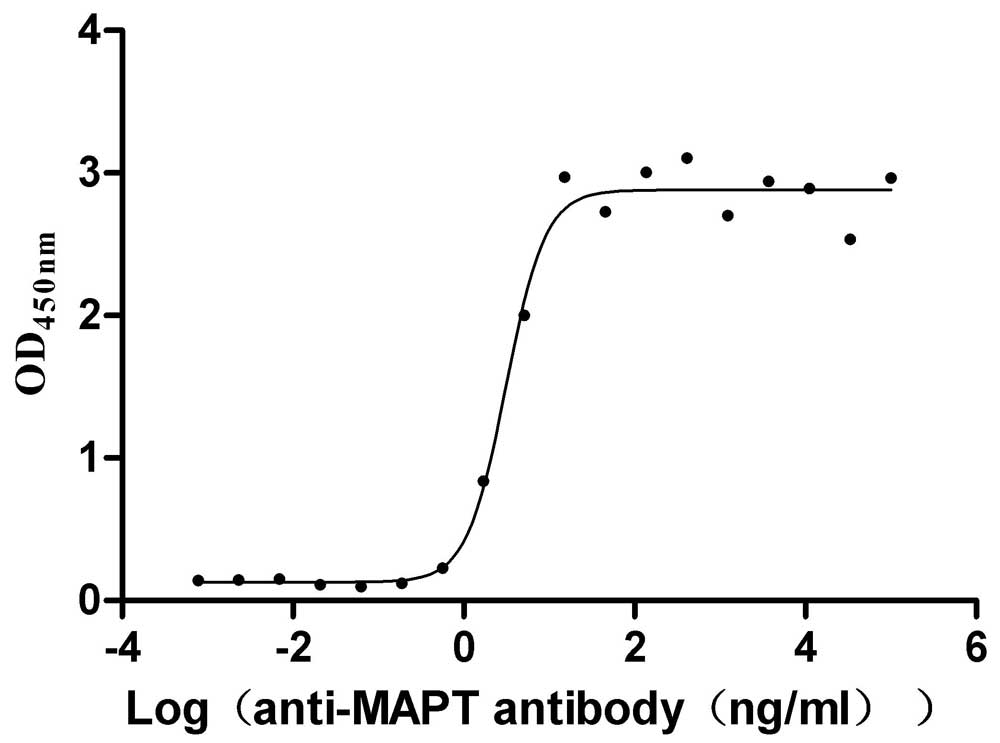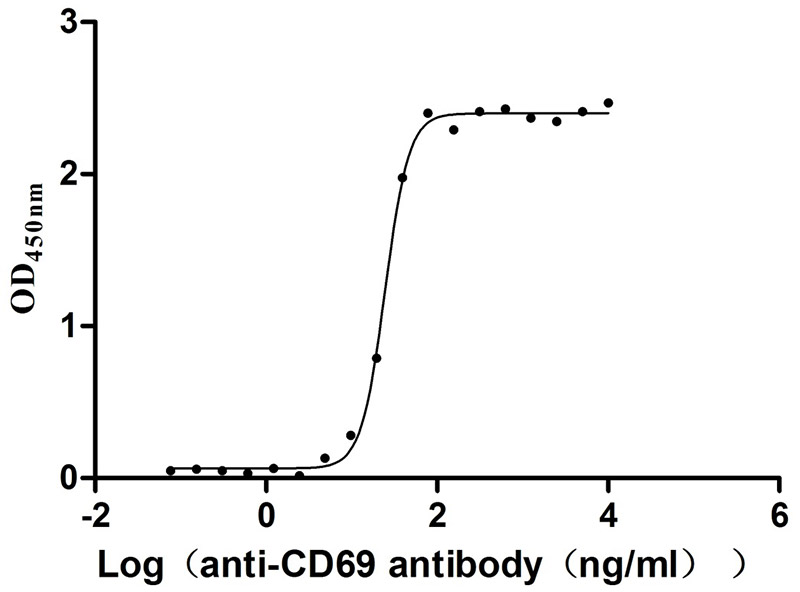Recombinant Human Glycosylphosphatidylinositol-anchored high density lipoprotein-binding protein 1 (GPIHBP1)
-
货号:CSB-CF811603HU
-
规格:
-
来源:in vitro E.coli expression system
-
其他:
产品详情
-
基因名:GPIHBP1
-
Uniprot No.:
-
别名:GPIHBP1; HBP1; Glycosylphosphatidylinositol-anchored high density lipoprotein-binding protein 1; GPI-HBP1; GPI-anchored HDL-binding protein 1; High density lipoprotein-binding protein 1
-
种属:Homo sapiens (Human)
-
蛋白长度:Full Length of Mature Protein
-
表达区域:21-184
-
氨基酸序列QTQQEEEEEDEDHGPDDYDEEDEDEVEEEETNRLPGGRSRVLLRCYTCKSLPRDERCNLT QNCSHGQTCTTLIAHGNTESGLLTTHSTWCTDSCQPITKTVEGTQVTMTCCQSSLCNVPP WQSSRVQDPTGKGAGGPRGSSETVGAALLLNLLAGLGAMGARRP
Note: The complete sequence including tag sequence, target protein sequence and linker sequence could be provided upon request. -
蛋白标签:N-terminal 10xHis-tagged
-
产品提供形式:Liquid or Lyophilized powder
Note: We will preferentially ship the format that we have in stock, however, if you have any special requirement for the format, please remark your requirement when placing the order, we will prepare according to your demand. -
缓冲液:Lyophilized from Tris/PBS-based buffer, 6% Trehalose, pH 8.0
-
储存条件:Store at -20°C/-80°C upon receipt, aliquoting is necessary for mutiple use. Avoid repeated freeze-thaw cycles.
-
保质期:The shelf life is related to many factors, storage state, buffer ingredients, storage temperature and the stability of the protein itself.
Generally, the shelf life of liquid form is 6 months at -20°C/-80°C. The shelf life of lyophilized form is 12 months at -20°C/-80°C. -
货期:Basically, we can dispatch the products out in 1-3 working days after receiving your orders. Delivery time may differ from different purchasing way or location, please kindly consult your local distributors for specific delivery time.Note: All of our proteins are default shipped with normal blue ice packs, if you request to ship with dry ice, please communicate with us in advance and extra fees will be charged.
-
注意事项:Repeated freezing and thawing is not recommended. Store working aliquots at 4°C for up to one week.
-
Datasheet & COA:Please contact us to get it.
相关产品
靶点详情
-
功能:Mediates the transport of lipoprotein lipase LPL from the basolateral to the apical surface of endothelial cells in capillaries. Anchors LPL on the surface of endothelial cells in the lumen of blood capillaries. Protects LPL against loss of activity, and against ANGPTL4-mediated unfolding. Thereby, plays an important role in lipolytic processing of chylomicrons by LPL, triglyceride metabolism and lipid homeostasis. Binds chylomicrons and phospholipid particles that contain APOA5. Binds high-density lipoprotein (HDL) and plays a role in the uptake of lipids from HDL.
-
基因功能参考文献:
- the negatively charged IDR of GPIHBP1 traverses a vast space, facilitating capture of LPL by capillary endothelial cells and simultaneously contributing to GPIHBP1's ability to preserve LPL structure and activity. PMID: 29899144
- The increased GPIHBP1 was significantly associated with decreased body weight. PMID: 29056530
- apoC-III potently inhibits triglyceride hydrolysis when LPL is bound to GPIHBP1 PMID: 28694296
- mutation of a conserved cysteine in GPIHBP1 abolishes the ability of GPIHBP1 to bind LPL PMID: 28476858
- One of 33 patients with unexplained chylomicronemia had the GPIHBP1 autoantibody syndrome PMID: 28666713
- Triglyceride-raising variant alleles of the GPIHBP1, encoding glycosylphosphatidylinositol-anchored HDL-binding protein 1,associated with clinical Cardiovascular endpoints. PMID: 28534127
- The s now show: (1) that ANGPTL4 inactivates LPL by catalyzing the unfolding of its hydrolase domain; (2) that binding to GPIHBP1 renders LPL largely refractory to this inhibition; and (3) that both the LU domain and the intrinsically disordered acidic domain of GPIHBP1 are required for this protective effect. PMID: 27929370
- familial chylomicronemia due to mutations in GPIHBP1 gene PMID: 27578123
- mAbs RE3 and RG3 bound with reduced affinity to a mutant GPIHBP1 containing an Ly6 domain mutation (W109S) that abolishes LPL binding. Immunohistochemistry studies with the GPIHBP1 mAbs revealed that human GPIHBP1 is expressed only in capillary endothelial cells. Finally, we created an ELISA that detects GPIHBP1 in human plasma. PMID: 27875259
- The binding of both antibody 88B8 and GPIHBP1 to LPL depends on large segments of LPL's carboxyl-terminal domain. PMID: 27494936
- An LPL structural model suggests that the LPL S447X truncation exposes residues implicated in LPL binding to lipoprotein binding uptake receptors, such as GPIHBP1. PMID: 27984852
- The acidic domain of GPIHBP1 stabilizes LPL catalytic activity by mitigating the global unfolding of LPL's catalytic domain. PMID: 26725083
- 2 novel GPIHBP1 missense mutations in 2 unrelated patients as the cause of their severe hypertriglyceridemia PMID: 26892125
- GPIHBP1 mutations should be considered in neonates with chylomicronemia negative for mutations in LPL gene PMID: 25911085
- the two domains of GPIHBP1 interact independently with LPL and the functionality of LPL depends on its localization on GPIHBP1 PMID: 25873395
- No GPIHBP1 mutations were identified in a cohort of patients with diabetic lipemia. PMID: 25131724
- patient with type I hyperlipoproteinemia harbored homozygous mutation in case series PMID: 24793350
- GPIHBP1 missense mutations leading to protein multimerization prevent lipoprotein lipase binding. PMID: 25387803
- Homozygosity for a deletion of exons 3 and 4 of GPIHBP1 results in Type 1 hyperlipoproteinemia. PMID: 24589565
- an extra cysteine in the GPIHBP1 Ly6 motif results in multimerization of GPIHBP1, defective LPL binding, and severe hypertriglyceridemia. PMID: 24847059
- Wild-type lipoprotein lipase (LPL) and a mutated (S447X-LPL) protein bind to the endothelial cell LPL transporter GPIHBP1 with equal efficiency. PMID: 24704550
- A polymorphism in the GPIHBP1 gene promoter was associated with an increased risk of hypertriglyceridemia and had an additive effect on the risk conferred by LPL defective alleles. PMID: 21978733
- Mutations in GPIHBP1 are rare but the associated clinical phenotype of hypertriglyceridaemia is severe. PMID: 22239554
- analysis of a neonate with complete GPIHBP1 deficiency due to homozygosity for a deletion of GPIHBP1 [case report] PMID: 22008945
- Expression of glycosylphosphatidylinositol-anchored high-density lipoprotein binding protein 1 tended to be higher in young healthy subjects than in subjects with type 2 diabetes mellitus or Colder control subjects PMID: 22078753
- function and genetics of GPIHBP1 in lipoprotein lipase transport PMID: 21844202
- we first report a mutation of the hydrophobic C-terminal domain that impairs GPIHBP1 membrane targeting PMID: 21816778
- Findings provide further evidence that GPIHBP1 is involved in the catabolism of triglyceride-rich lipoproteins and plays a role in childhood-onset chylomicronaemia. PMID: 21314738
- the Ly6 domain of GPIHBP1 is important for the ability of GPIHBP1 to bind and transport LPL. PMID: 21478160
- report that two LPL missense mutations initially identified in patients with chylomicronemia, C418Y and E421K, abolish LPL's ability to bind to GPIHBP1 without interfering with LPL catalytic activity or binding to heparin PMID: 21518912
- GPIHBP1 binds lipoprotein lipase but does not bind other lipase family members. GPIHBP1 binds apoAV but does not bind apoAI or high-density lipoprotein. GPIHBP1 binding to chylomicrons is mediated by lipoprotein lipase. PMID: 20966398
- The conserved cysteines in the Ly6 domain are crucial for GPIHBP1 function. PMID: 20026666
- Observational study of gene-disease association. (HuGE Navigator) PMID: 20237496
- GPIHBP1 functions as an LPL stabilizer PMID: 19542565
- a very rare GPIHBP1 missense mutation appears to be associated with severe hypertriglyceridemia and chylomicronemia. PMID: 17883852
- Data show that the G56R substitution did not affect the ability of GPIHBP1 to reach the cell surface, nor did the amino acid substitution have any discernible effect on the binding of lipoprotein lipase, chylomicrons, or apo-AV. PMID: 17997385
- the acidic domain of GPIHBP1 is important and electrostatic interactions play a key role in ligand binding PMID: 18713736
- Case Report: Chylomicronemia with a mutant GPIHBP1 (Q115P) that cannot bind lipoprotein lipase. PMID: 19304573
显示更多
收起更多
-
相关疾病:Hyperlipoproteinemia 1D (HLPP1D)
-
亚细胞定位:Apical cell membrane; Lipid-anchor, GPI-anchor. Basolateral cell membrane; Lipid-anchor, GPI-anchor. Cell membrane; Lipid-anchor, GPI-anchor.
-
数据库链接:
HGNC: 24945
OMIM: 612757
KEGG: hsa:338328
STRING: 9606.ENSP00000329266
UniGene: Hs.426410
Most popular with customers
-
Recombinant Human Poliovirus receptor (PVR) (I340M), partial (Active)
Express system: Mammalian cell
Species: Homo sapiens (Human)
-
Recombinant Macaca mulatta Microtubule-associated protein tau (MAPT) (Active)
Express system: Mammalian cell
Species: Macaca mulatta (Rhesus macaque)
-
Recombinant Human Claudin-6 (CLDN6)-VLPs (Active)
Express system: Mammalian cell
Species: Homo sapiens (Human)
-
Recombinant Human Carcinoembryonic antigen-related cell adhesion molecule 6 (CEACAM6) (Active)
Express system: Mammalian cell
Species: Homo sapiens (Human)
-
Recombinant Human Early activation antigen CD69 (CD69), partial (Active)
Express system: Mammalian cell
Species: Homo sapiens (Human)
-
Recombinant Human Cell adhesion molecule 1 (CADM1), partial (Active)
Express system: Mammalian cell
Species: Homo sapiens (Human)
-
Recombinant Rat Gastric inhibitory polypeptide receptor (Gipr), partial (Active)
Express system: Mammalian cell
Species: Rattus norvegicus (Rat)
-
Recombinant Macaca fascicularis C-type lectin domain family 4 member C(CLEC4C), partial (Active)
Express system: Mammalian cell
Species: Macaca fascicularis (Crab-eating macaque) (Cynomolgus monkey)


-AC1.jpg)

-AC1.jpg)















